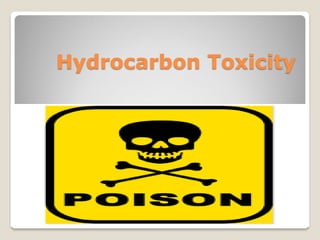
Hydrocarbon Toxicity
- 2. are a heterogenous group of organic substances that are primarily composed of carbon and hydrogen molecules the most commonly ingested hydrocarbons: gasoline, lubricating oil, motor oil, mineral spirits, lighter fluid/naphtha, lamp oil, and kerosene. Other common sources of hydrocarbons: dry cleaning solutions, paint, spot remover, rubber cement, and solvents volatile substances(eg, glue, propellants) are commonly abused for their euphoric effects.
- 3. Toxicity from hydrocarbon ingestion can affect many organs lungs are the most commonly affected. recreational use of inhaling hydrocarbons for the purposes of creating a euphoric state is becoming increasingly common methods used for this abuse: 1."sniffing" (directly inhaling vapors) 2."huffing" (placing a hydrocarbon-saturated rag over the mouth and nose and then inhaling) 3."bagging" (inhaling via a plastic bag filled with hydrocarbon vapors).
- 4. Clinical presentation The lung is the primary site of most common toxicity Pulmonary toxicity most often occurs following ingestion and subsequent aspiration of hydrocarbon. Respiratory symptoms (eg, coughing, gagging, choking) usually occur within 30 minutes of exposure but often can be delayed several hours. Many patients develop a transient cough. A prolonged cough and hypoxia, however, is more concerning for aspiration.
- 5. Nervous system most common CNS symptoms include headache, lethargy, and decreased mental status. Because many of the solvents are highly lipophilic, solvent abuse causes a transient euphoria. With prolonged exposure to n -hexane, MnBK, and possibly toluene, an axonopathy can occur. This peripheral neuropathy usually begins in the extremities and then progresses more proximally.
- 6. Cardiovascular The patient may complain of dyspnea or syncope. In addition, because of sensitization of the myocardium to catecholamines, a relatively young and previously healthy patient can present in full cardiac arrest after being suddenly startled or following strenuous athletic events.
- 7. Gastrointestinal Nausea, vomiting, and sore throat are frequent but are relatively mild. Local reactions: burning sensation in the mouth, pruritus, or a perioral rash are common and are usually mild. Diarrhea, melena, and hematemesis are rare.
- 8. Labs: Pulse oximetry should be performed on all patients to evaluate oxygenation. Complete blood count Chronic benzene exposure may produce either acute myelogenous leukemia or aplastic anemia. In the acute ingestion, leukocytosis can occur. Anemia can occur as a result of intravascular hemolysis.
- 9. BUN, creatinine, glucose, electrolytes, and anion gap serum glucose level The anion gap will most likely be normal, but in acute toluene intoxication, an elevated anion gap can be present. The presence of an anion gap, especially if associated with a profound acidosis in a patient appearing intoxicated, however, should prompt an evaluation for other etiologies (eg, methanol, ethylene glycol, salicylates). Acute renal failure following massive hydrocarbon ingestion can occur but is rare. hepatic transaminase levels should be done serum creatine kinase (CK) level should be obtained, as acute rhabdomyolysis has been reported in hydrocarbon intoxication.
- 10. Chest radiography Patients who are asymptomatic should not have a chest radiograph obtained immediately. Rather, asymptomatic patients should have chest radiography performed at the end of a 6-hour observation period.
- 11. ECG should be done to assess for arrhythmias, especially in those individuals with suspected hydrocarbon abuse
- 12. Prehospital Care should focus on decontamination, followed by immediate transport to a medical facility capable of managing such a patient. GI decontamination has no role in prehospital care. Decontamination should focus on removing any remaining hydrocarbon that might be on the clothes or skin, in the correct clinical setting. Patients should be kept calm to prevent arrhythmia as a result of myocardial sensitization. All patients should have their airway, breathing, and circulation managed per routine advanced life support protocols. Symptomatic patients should receive intravenous access and cardiac monitoring. The hydrocarbon agent should be transported with the patient to the hospital, if this can be done in a safe manner. Bringing the substance to the hospital can permit identification.
- 13. Emergency Department Care Supportive management Asymptomatic patients should be observed with pulse-oximetry for a period of at least 6 hours. If the patient remains asymptomatic then a chest radiograph may be obtained to evaluate for aspiration. Patients with impending respiratory failure despite supplemental oxygen may require rapid sequence intubation for definitive airway management. If arrhythmias occur, electrolytes, including magnesium and potassium, should be replaced. If ventricular fibrillation occurs because of myocardial sensitization, catecholamines, including epinephrine, should be avoided. In this setting, lidocaine or beta-blockers can be used.
- 14. Decontamination of the GI tract remains controversial. The use of ipecac-induced emesis is contraindicated, and activated charcoal does not absorb hydrocarbons well. Gastric lavage should not be routinely performed. The hydrocarbons with significant systemic toxicity for which the benefits of gastric decontamination may outweigh the real risks of inducing aspiration follow the mnemonic CHAMP:
- 15. Camphor (toxicity is seizures) Halogenated hydrocarbons (toxicity is arrhythmias and hepatotoxicity) Aromatic hydrocarbons (toxicity is CNS toxicity, myelosuppression, and malignancy) Metals (heavy metals) Pesticides (cholinergic symptoms, seizures) Antibiotics are given to patients who develop a pneumonitis following hydrocarbon aspiration. Clinically, superinfection can definitely occur. Because the pneumonitis itself can create abnormal lung sounds, fever, and leukocytosis, distinguishing if these effects are because of a superimposed infection or if they are the result of the pneumonitis itself is often difficult. Any finding on CXR within a few hours of the exposure is unlikely to be pneumonia, and more likely to be a pneumonitis. Steroids have not been proven to be beneficial. Psychiatry consultation should be performed if deemed clinically relevan
- 16. http://crisbertcualteros.page.tl Source: Medscape Harrisons Oxford handbook
